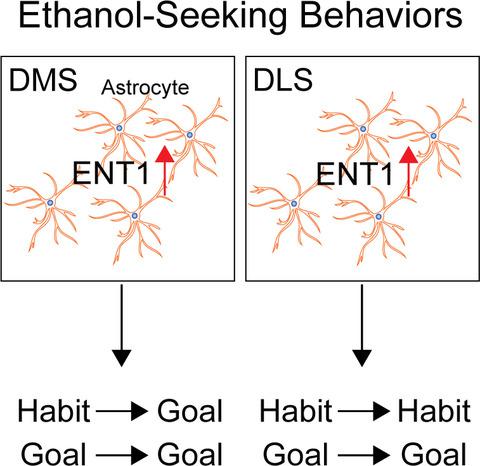当前位置:
X-MOL 学术
›
Eur. J. Nerosci.
›
论文详情
Our official English website, www.x-mol.net, welcomes your feedback! (Note: you will need to create a separate account there.)
Astrocytic equilibrative nucleoside transporter type 1 upregulations in the dorsomedial and dorsolateral striatum distinctly coordinate goal-directed and habitual ethanol-seeking behaviours in mice.
European Journal of Neroscience ( IF 3.4 ) Pub Date : 2020-05-13 , DOI: 10.1111/ejn.14752 Sa-Ik Hong 1 , Amanda Bullert 1 , Matthew Baker 1 , Doo-Sup Choi 1, 2, 3
European Journal of Neroscience ( IF 3.4 ) Pub Date : 2020-05-13 , DOI: 10.1111/ejn.14752 Sa-Ik Hong 1 , Amanda Bullert 1 , Matthew Baker 1 , Doo-Sup Choi 1, 2, 3
Affiliation

|
Two distinct dorsal striatum regions, dorsomedial striatum (DMS) and dorsolateral striatum (DLS), are attributed to conditioned goal‐directed and habitual reward‐seeking behaviours, respectively. Previously, our study shows that the ethanol‐sensitive adenosine transporter, equilibrative nucleoside transporter 1 (ENT1), regulates ethanol‐drinking behaviours. Although ENT1 is expressed in both neurons and astrocytes, astrocytic ENT1 is thought to regulate adenosine levels in response to ethanol. However, the role of DMS and DLS astrocytic ENT1 in goal‐directed and habitual ethanol‐seeking is not well known. Here, we identified whether the upregulation of astrocytic ENT1 in the DMS and DLS differentially regulates operant seeking behaviours towards the 10% sucrose (10S); 10% ethanol and 10% sucrose (10E10S); and 10% ethanol (10E) in mice. Using 4 days of random interval (RI), mice exhibited habitual seeking for 10S, but goal‐directed seeking towards 10E10S. Using the same mice conditioned with 10E10S, we examined 10E‐seeking behaviour on a fixed ratio (FR) for 6 days and RI for 8 days. On the other hand, during FR and the first 4 days of RI schedules, mice showed goal‐directed seeking for 10E, whereas mice exhibited habitual seeking for 10E during the last 4 days of RI schedule. Interestingly, DMS astrocytic ENT1 upregulation promotes shift from habitual to goal‐directed reward‐seeking behaviours. By contrast, DLS astrocytic ENT1 upregulation showed no effects on behavioural shift. Taken together, our findings demonstrate that DMS astrocytic ENT1 contributes to reward‐seeking behaviours.
中文翻译:

背内侧和背外侧纹状体中星形胶质细胞平衡核苷转运蛋白 1 型上调明显协调小鼠的目标导向和习惯性乙醇寻求行为。
两个不同的背侧纹状体区域,背内侧纹状体 (DMS) 和背外侧纹状体 (DLS),分别归因于条件性目标导向和习惯性的奖励寻求行为。此前,我们的研究表明,乙醇敏感的腺苷转运蛋白,平衡核苷转运蛋白 1 (ENT1),调节乙醇饮用行为。尽管 ENT1 在神经元和星形胶质细胞中均有表达,但星形胶质细胞 ENT1 被认为可响应乙醇调节腺苷水平。然而,DMS 和 DLS 星形胶质细胞 ENT1 在目标导向和习惯性乙醇寻求中的作用尚不清楚。在这里,我们确定了 DMS 和 DLS 中星形胶质细胞 ENT1 的上调是否对 10% 蔗糖 (10S) 的操作性寻求行为进行了差异调节;10% 乙醇和 10% 蔗糖 (10E10S);和 10% 乙醇 (10E) 在小鼠中。使用 4 天的随机间隔 (RI),小鼠表现出对 10S 的习惯性寻找,但对 10E10S 进行目标导向的寻找。使用用 10E10S 调节的相同小鼠,我们检查了 6 天固定比率 (FR) 和 RI 8 天的 10E 寻求行为。另一方面,在 FR 和 RI 计划的前 4 天,小鼠表现出目标导向的 10E 寻求,而小鼠在 RI 计划的最后 4 天表现出对 10E 的习惯性寻求。有趣的是,DMS 星形胶质细胞 ENT1 上调促进了从习惯性到目标导向的奖励寻求行为的转变。相比之下,DLS 星形胶质细胞 ENT1 上调对行为转变没有影响。总之,我们的研究结果表明 DMS 星形胶质细胞 ENT1 有助于寻求奖励的行为。但目标导向的寻求 10E10S。使用用 10E10S 调节的相同小鼠,我们检查了 6 天固定比率 (FR) 和 RI 8 天的 10E 寻求行为。另一方面,在 FR 和 RI 计划的前 4 天,小鼠表现出目标导向的 10E 寻求,而小鼠在 RI 计划的最后 4 天表现出对 10E 的习惯性寻求。有趣的是,DMS 星形胶质细胞 ENT1 上调促进了从习惯性到目标导向的奖励寻求行为的转变。相比之下,DLS 星形胶质细胞 ENT1 上调对行为转变没有影响。总之,我们的研究结果表明 DMS 星形胶质细胞 ENT1 有助于寻求奖励的行为。但目标导向的寻求 10E10S。使用用 10E10S 调节的相同小鼠,我们检查了 6 天固定比率 (FR) 和 RI 8 天的 10E 寻求行为。另一方面,在 FR 和 RI 计划的前 4 天,小鼠表现出目标导向的 10E 寻求,而小鼠在 RI 计划的最后 4 天表现出对 10E 的习惯性寻求。有趣的是,DMS 星形胶质细胞 ENT1 上调促进了从习惯性到目标导向的奖励寻求行为的转变。相比之下,DLS 星形胶质细胞 ENT1 上调对行为转变没有影响。总之,我们的研究结果表明 DMS 星形胶质细胞 ENT1 有助于寻求奖励的行为。在 FR 和 RI 计划的前 4 天,小鼠表现出目标导向的 10E 寻求,而小鼠在 RI 计划的最后 4 天表现出对 10E 的习惯性寻求。有趣的是,DMS 星形胶质细胞 ENT1 上调促进了从习惯性到目标导向的奖励寻求行为的转变。相比之下,DLS 星形胶质细胞 ENT1 上调对行为转变没有影响。总之,我们的研究结果表明 DMS 星形胶质细胞 ENT1 有助于寻求奖励的行为。在 FR 和 RI 计划的前 4 天,小鼠表现出目标导向的 10E 寻求,而小鼠在 RI 计划的最后 4 天表现出对 10E 的习惯性寻求。有趣的是,DMS 星形胶质细胞 ENT1 上调促进了从习惯性到目标导向的奖励寻求行为的转变。相比之下,DLS 星形胶质细胞 ENT1 上调对行为转变没有影响。总之,我们的研究结果表明 DMS 星形胶质细胞 ENT1 有助于寻求奖励的行为。DLS 星形胶质细胞 ENT1 上调显示对行为转变没有影响。总之,我们的研究结果表明 DMS 星形胶质细胞 ENT1 有助于寻求奖励的行为。DLS 星形胶质细胞 ENT1 上调显示对行为转变没有影响。总之,我们的研究结果表明 DMS 星形胶质细胞 ENT1 有助于寻求奖励的行为。
更新日期:2020-05-13
中文翻译:

背内侧和背外侧纹状体中星形胶质细胞平衡核苷转运蛋白 1 型上调明显协调小鼠的目标导向和习惯性乙醇寻求行为。
两个不同的背侧纹状体区域,背内侧纹状体 (DMS) 和背外侧纹状体 (DLS),分别归因于条件性目标导向和习惯性的奖励寻求行为。此前,我们的研究表明,乙醇敏感的腺苷转运蛋白,平衡核苷转运蛋白 1 (ENT1),调节乙醇饮用行为。尽管 ENT1 在神经元和星形胶质细胞中均有表达,但星形胶质细胞 ENT1 被认为可响应乙醇调节腺苷水平。然而,DMS 和 DLS 星形胶质细胞 ENT1 在目标导向和习惯性乙醇寻求中的作用尚不清楚。在这里,我们确定了 DMS 和 DLS 中星形胶质细胞 ENT1 的上调是否对 10% 蔗糖 (10S) 的操作性寻求行为进行了差异调节;10% 乙醇和 10% 蔗糖 (10E10S);和 10% 乙醇 (10E) 在小鼠中。使用 4 天的随机间隔 (RI),小鼠表现出对 10S 的习惯性寻找,但对 10E10S 进行目标导向的寻找。使用用 10E10S 调节的相同小鼠,我们检查了 6 天固定比率 (FR) 和 RI 8 天的 10E 寻求行为。另一方面,在 FR 和 RI 计划的前 4 天,小鼠表现出目标导向的 10E 寻求,而小鼠在 RI 计划的最后 4 天表现出对 10E 的习惯性寻求。有趣的是,DMS 星形胶质细胞 ENT1 上调促进了从习惯性到目标导向的奖励寻求行为的转变。相比之下,DLS 星形胶质细胞 ENT1 上调对行为转变没有影响。总之,我们的研究结果表明 DMS 星形胶质细胞 ENT1 有助于寻求奖励的行为。但目标导向的寻求 10E10S。使用用 10E10S 调节的相同小鼠,我们检查了 6 天固定比率 (FR) 和 RI 8 天的 10E 寻求行为。另一方面,在 FR 和 RI 计划的前 4 天,小鼠表现出目标导向的 10E 寻求,而小鼠在 RI 计划的最后 4 天表现出对 10E 的习惯性寻求。有趣的是,DMS 星形胶质细胞 ENT1 上调促进了从习惯性到目标导向的奖励寻求行为的转变。相比之下,DLS 星形胶质细胞 ENT1 上调对行为转变没有影响。总之,我们的研究结果表明 DMS 星形胶质细胞 ENT1 有助于寻求奖励的行为。但目标导向的寻求 10E10S。使用用 10E10S 调节的相同小鼠,我们检查了 6 天固定比率 (FR) 和 RI 8 天的 10E 寻求行为。另一方面,在 FR 和 RI 计划的前 4 天,小鼠表现出目标导向的 10E 寻求,而小鼠在 RI 计划的最后 4 天表现出对 10E 的习惯性寻求。有趣的是,DMS 星形胶质细胞 ENT1 上调促进了从习惯性到目标导向的奖励寻求行为的转变。相比之下,DLS 星形胶质细胞 ENT1 上调对行为转变没有影响。总之,我们的研究结果表明 DMS 星形胶质细胞 ENT1 有助于寻求奖励的行为。在 FR 和 RI 计划的前 4 天,小鼠表现出目标导向的 10E 寻求,而小鼠在 RI 计划的最后 4 天表现出对 10E 的习惯性寻求。有趣的是,DMS 星形胶质细胞 ENT1 上调促进了从习惯性到目标导向的奖励寻求行为的转变。相比之下,DLS 星形胶质细胞 ENT1 上调对行为转变没有影响。总之,我们的研究结果表明 DMS 星形胶质细胞 ENT1 有助于寻求奖励的行为。在 FR 和 RI 计划的前 4 天,小鼠表现出目标导向的 10E 寻求,而小鼠在 RI 计划的最后 4 天表现出对 10E 的习惯性寻求。有趣的是,DMS 星形胶质细胞 ENT1 上调促进了从习惯性到目标导向的奖励寻求行为的转变。相比之下,DLS 星形胶质细胞 ENT1 上调对行为转变没有影响。总之,我们的研究结果表明 DMS 星形胶质细胞 ENT1 有助于寻求奖励的行为。DLS 星形胶质细胞 ENT1 上调显示对行为转变没有影响。总之,我们的研究结果表明 DMS 星形胶质细胞 ENT1 有助于寻求奖励的行为。DLS 星形胶质细胞 ENT1 上调显示对行为转变没有影响。总之,我们的研究结果表明 DMS 星形胶质细胞 ENT1 有助于寻求奖励的行为。

























 京公网安备 11010802027423号
京公网安备 11010802027423号